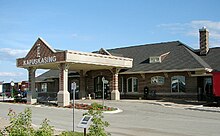
Timmins is a city in northeastern Ontario, Canada, located on the Mattagami River. The city is the fourth-largest city in the Northeastern Ontario region with a population of 41,145 at the 2021 Canadian census and an estimated population of 44,819 in 2023. The city's economy is based on natural resource extraction. It is supported by industries related to lumbering, and to the mining of gold, zinc, copper, nickel, and silver. Timmins serves as a regional service and distribution centre.
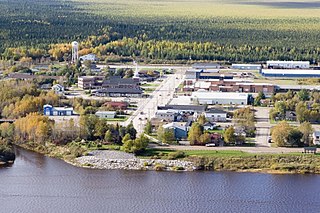
Moosonee is a town in northern Ontario, Canada, on the Moose River approximately 19 km (12 mi) south of James Bay. It is considered to be "the Gateway to the Arctic" and has Ontario's only saltwater port. Nearby on Moose Factory Island is the community of Moose Factory to which it is connected by water taxi in the summer and ice road in the winter.
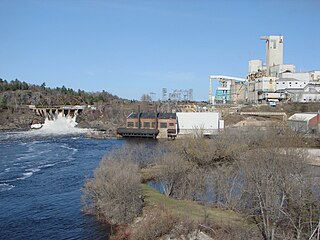
Espanola is a town in Northern Ontario, Canada, in the Sudbury District. It is situated on the Spanish River, approximately 70 kilometres (43 mi) west of downtown Sudbury, and just south of the junction of Highway 6 and Highway 17. The town is where the first experimental rules for the sport of ringette were created in 1963 by Mirl Arthur "Red" McCarthy using a group of local high school girls. Today, Espanola is considered "The Home of Ringette" while North Bay, Ontario, is considered "The Birthplace of Ringette" though the title is often shared by both.

Cochrane is a town in northeastern Ontario, Canada. It is located east of Kapuskasing, northeast of Timmins, south of Moosonee, and north of Iroquois Falls. It is about a one-hour drive from Timmins and Kapuskasing, the other two major population centres of the region. It is the seat of Cochrane District. The town's population is made up of about half anglophone and half francophone residents.

West Nipissing is a municipality in Northeastern Ontario, Canada, on Lake Nipissing in the Nipissing District. It was formed on January 1, 1999, with the amalgamation of seventeen and a half former towns, villages, townships and unorganized communities.

Iroquois Falls is a town in Northern Ontario, Canada, with a population of 4,537 at the 2016 census.

Hearst is a town in the district of Cochrane, Ontario, Canada. It is located on the Mattawishkwia River in Northern Ontario, approximately 92 kilometres (57 mi) west of Kapuskasing, approximately 520 kilometres (320 mi) east of Thunder Bay along Highway 11. At Hearst, Highway 583 extends northward to Lac-Sainte-Thérèse and southward to Jogues, Coppell and Mead.
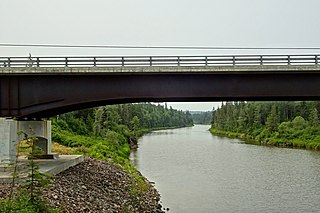
The Pic River is a river in the east part of Thunder Bay District in northwestern Ontario, Canada. It flows from McKay Lake southeast of the community of Longlac and empties into Lake Superior southeast of the town of Marathon.
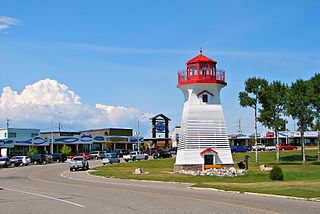
Terrace Bay is a township in Thunder Bay District in northern Ontario, Canada, located on the north shore of Lake Superior east of Thunder Bay along Highway 17. The name originates from a series of lake terraces formed as the water level in Lake Superior lowered following the latest ice age.
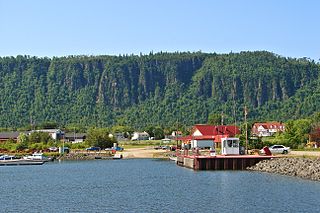
Red Rock is a township in Northwestern Ontario, Canada, located in the Thunder Bay District. The community of Red Rock sits on the shore of Lake Superior, just south of where the Nipigon River drains into Nipigon Bay on the north shore of Lake Superior. The population as of 2021 is 895.
Dalhousie was a town in Restigouche County, New Brunswick from 1905 to 2023. It was amalgamated with Charlo to form the town of Heron Bay. The name Dalhousie is still retained for address purposes. Heron Bay is the northernmost municipality in New Brunswick.
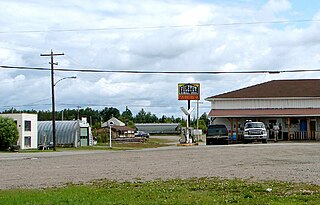
Foleyet is an unincorporated community in the Unorganized North Part of Sudbury District in Northeastern Ontario, Canada, midway between Chapleau and Timmins on Highway 101. The town was created during the construction of the Canadian Northern Railway (CNR) through the area in the early years of the 20th century.

Smooth Rock Falls is an incorporated town in the Cochrane District in Northeastern Ontario, Canada, with a population of 1,330 at the 2016 census.

Baldwin is a township in the Canadian province of Ontario. Located in Sudbury District north of Espanola, the township's two main communities and population centres are McKerrow and Lorne.

Mattice-Val Côté is an incorporated township in Cochrane District in Northeastern Ontario, Canada. It is located approximately 30 kilometres (19 mi) east of Hearst and 70 kilometres (43 mi) west of Kapuskasing on Ontario Highway 11.

Ear Falls is a township located in Northwestern Ontario, Canada, on the banks of the English River, Lac Seul, Pakwash Lake and Wenesaga Lake. It is located along Highway 105, 100 kilometres (62 mi) north of Highway 17 and Vermilion Bay, about halfway between Highway 17 and Red Lake, or about 480 kilometres (300 mi) northwest of Thunder Bay.
Elsas railway station is a railway station in the community of Elsas in the Unorganized North part of Algoma District in northeastern Ontario, Canada. The station is on the Canadian National Railway transcontinental railway main line between the railway points of Agate to the west and Oatland to the east, and is a stop for Via Rail transcontinental Canadian trains. The station and settlement are on the northern shore of Kapuskasing Lake, the source of the Kapuskasing River.
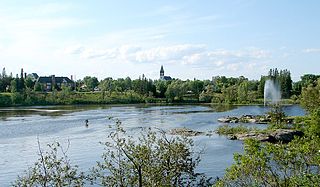
The Kapuskasing River is a river in the James Bay drainage basin in Cochrane District and Algoma District in northeastern Ontario, Canada. The river is a left tributary of the Mattagami River.
Smoky Falls Generating Station is one of four stations in the Lower Mattagami River Hydroelectric Complex owned by Ontario Power Generation (OPG) and the Moose Cree First Nation. The station is approximately 85 km (53 mi) northeast of Kapuskasing in the Cochrane District of Northern Ontario. Smoky Falls was originally commissioned as a 54 MW generating station in 1931 by the Spruce Falls Power and Paper Company but it was sold to OPG's predecessor, Ontario Hydro, in 1991. OPG completed a $2.6 billion upgrade of the four Lower Mattagami dams in 2014 and 2015. The new Smoky Falls was commissioned in late 2014 with a 267.9 MW installed capacity.
Elsas is an unincorporated place and railway point in geographic Kapuskasing Township, in the Unorganized North part of Algoma District in northeastern Ontario, Canada. It is on the Canadian National Railway transcontinental railway main line between the railway points of Agate to the west and Oatland to the east, and is the location of Elsas railway station, a stop for Via Rail transcontinental Canadian trains. The station and settlement are on the northern shore of Kapuskasing Lake, the source of the Kapuskasing River.






